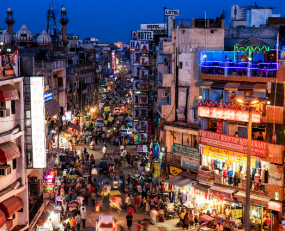
The new edition of the IMF World Economic Outlook, released at the beginning of October, paints a picture of the global economy characterized by slow and uneven growth, with projected figures of 3% for 2023 and 2.9% for 2024. The battle against rising prices, coupled with growing disparities among countries and regions, is posing challenges for those trying to achieve higher living standards. Amidst these trends, India stands out as a leading player. According to the IMF’s October update, India’s economy is expected to grow by 6.3% in 2023, marking an increase from the earlier projection of 6.1%.
The Indian Development Update (IDU), the Bank’s flagship biannual report on the Indian economy, highlights that despite considerable global obstacles, India managed to emerge as one of the fastest-growing major economies in FY22/23, with a growth rate of 7.2%. In fact, India’s growth rate was the second highest among G20 nations, nearly double the average for emerging market economies.
Economists attribute India’s growth to factors such as increased consumer spending, investments in infrastructure, and a growing number of businesses establishing themselves in the country. However, they caution that challenges remain, and these could be exacerbated by resurging inflation and geopolitical tensions. On a positive note, the service sector is expected to remain robust with a growth rate of 7.4%, and investment growth is projected to stay strong at 8.9%. Additionally, India’s consumer market is set to become the world’s third largest by 2027, driven by the rise in middle to high-income households, as reported by BMI, a unit of Fitch Solutions.
So, what does all this mean for the logistics industry in India?
In essence, India’s robust economic growth is poised to significantly boost demand and innovation in the logistics sector. As the economy expands, the logistics industry will need to adapt to meet the evolving requirements of businesses and consumers. This will encompass addressing environmental concerns and navigating regulatory changes.
Economic growth is known to lead to heightened consumption, increased production, and expanded trade activities. Consequently, the logistics industry can anticipate a surge in demand for services related to the transportation of raw materials, finished goods, and other products.
As economic growth continues, there is often a corresponding emphasis on improving infrastructure, with governments and private investors investing in the development of better roads, ports, railways, and airports. These infrastructure improvements can lead to more efficient and cost-effective logistics operations.
Furthermore, the growth of e-commerce, closely linked to economic expansion, is giving rise to a need for efficient last-mile delivery and warehousing solutions. The logistics industry in India has experienced notable growth due to the expansion of e-commerce platforms and their specific logistics requirements.
In summary, India’s economic growth is set to be a driving force behind the logistics industry’s expansion and adaptation, responding to the changing landscape as the Indian economy continues to prosper.